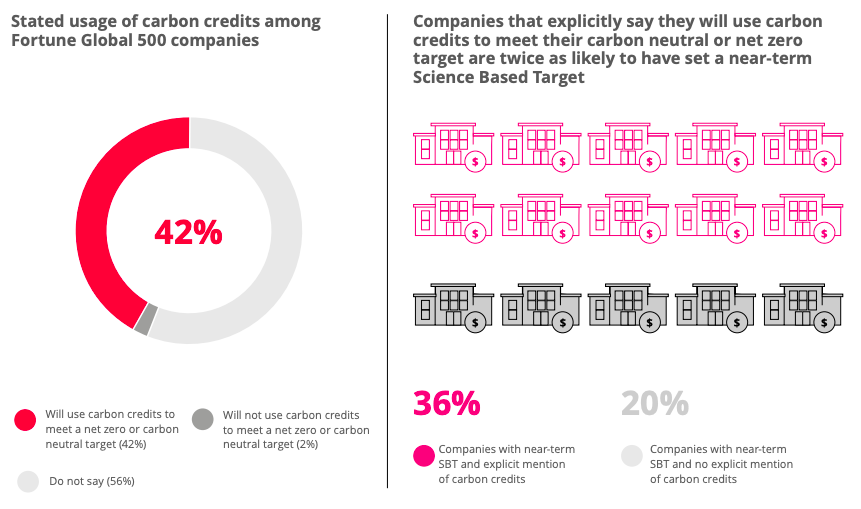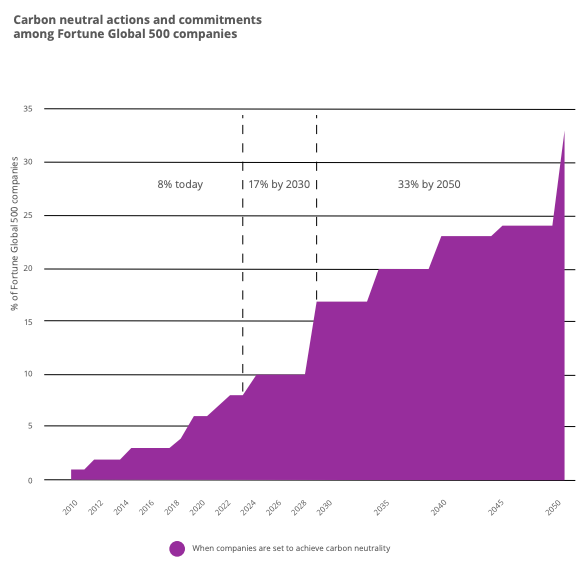Carbon neutrality is what a company or organization achieves when the amount of CO2 they have emitted into the atmosphere has been balanced out. This means it has either been removed or mitigated through carbon offset projects or technologies that capture and store carbon.
While carbon neutral and net zero are terms that are often used interchangeably, they do mean slightly different things. Both refer to the balance in the amount of greenhouse gasses emitted and removed from the atmosphere. In that regard both terms lead to the same result, although they refer to different kinds of emissions and the scale in which they are removed.
Carbon neutrality has more of an emphasis on the removal and reduction of CO2 while the focus of net zero is broader and addresses all greenhouse gasses across all industries. For example, net zero can encompass the removal of methane (CH4), nitrous oxide (N2O), and fluorinated gasses, from sectors like energy, industry, transportation, or agriculture.
The terms are often used in different contexts as well. Net zero is favored by governments and political bodies when setting international climate goals and national policies, while carbon neutrality is more likely to be used by businesses and organizations for their operational emissions.
Carbon neutrality can incorporate carbon offsetting, which is the idea that companies or organizations can compensate for their emissions by investing in projects like reforestation or renewable energy initiatives, which remove carbon from the atmosphere.
Net zero allows for the possibility of any leftover emissions to be offset but emphasizes the reduction of emissions as a priority. A company aiming for net zero would first need to eliminate all of its greenhouse gas emissions.
To circumvent the worst aspects of climate change, we need to halve all global greenhouse gas emissions by 2030 with the goal of reaching net zero by the middle of the century. More than 90 countries across the world have set net zero targets, including the United States, India, and China - some of the world's worst emitters - while the number of companies setting net zero targets has grown by 40% from 2022 to 2023 alone. That’s now more than 1,000 of the world’s biggest companies committing to carbon neutrality.
Yet, despite there never being a more concerted effort from countries and organizations to reach net zero, the world is currently not on track to limiting global temperature rise to 1.5°C. At the current rate, we will exceed 1.5°C and reach 2.7°C by the end of the century. If we are to stay below 1.5°C, the world will have to reach net zero between 2050 and 2060. Companies need to be doing their part to reach these goals.

To achieve carbon neutrality and net zero by these dates will require a massive and rapid transformation of all industries and systems. There will have to be a shift to renewable energy technology and the energy we do use will have to be consumed with greater efficiency. These changes will vary across different sectors and industries but will include:
Energy production
Transportation
Manufacturing
Construction and the built environment
Agriculture
Information Technology
Waste Management
In tandem with these changes, these industries will also have to offset their current carbon dioxide emissions. Offsetting can be done before more difficult and costly transitions are made or during the transitioning process.

Carbon offsets can be a key component to achieving carbon neutrality and net zero by providing tools to negate emissions that are challenging to remove. Offsets also allow for the funding and awareness of sustainability projects and encourage the development and innovation of greenhouse gas reducing technologies.
Offsetting projects can include reforestation and afforestation, renewable energy projects like wind farms or solar power plants, methane capture projects, energy efficiency improvements, carbon sequestration, avoided deforestation, and many more.
To ensure best practices for the effective use of carbon offsets, these offsets need to be verified by third-party organizations. Measurement, reporting, and verification (MRV) processes ensure that emissions reductions are accurately measured, transparently reported, and independently verified.
Offsetting projects need to be able to prove a number of factors to illustrate their quality. They need to show permanence, ensuring the long-term sequestration of carbon. This means that the carbon dioxide removed or prevented from entering the atmosphere will be done so for a long period of time, typically 100 years.
These projects also need to avoid double counting the emissions they prevent and that they are additional to what would have occurred without the project.

To ensure a company credibly achieves carbon neutrality or net zero status there are a number of standards, regulations, and certifications these organizations can adhere to.
Greenhouse Gas Protocol (GHG Protocol)
The Greenhouse Gas Protocol is a detailed global standard for public and private sector entities to measure and manage greenhouse gas emissions. The comprehensive framework was established in 1990 out of a need for a consistent way to report emissions.
Among the those that use the protocol are businesses, governments, non-governmental organizations (NGOs), non-profits, cities and municipalities, universities and research institutions, consulting firms, industry associations, and more. The protocol is useful precisely because it can be used by so many different entities to accurately track emissions.
Science Based Targets Initiative (SBTi)
Established by a cooperative between the CDP, the United Nations Global Compact, World Resources Institute, and the World Wide Fund for Nature (WWF), Science Based Targets Initiative offers a framework of reduction targets and guidance in line with the Paris Agreement.
CarbonNeutral® Certification

Created in 2002, the CarbonNeutral Protocol is an annually updated framework for carbon neutral programs. It provides clear, credible, and transparent guidance that reflects the latest scientific, policy, and business developments.
Certification is structured in five steps: defining what your claim will cover, measuring your emissions, targeting reductions, reducing emissions through internal reductions and external offsetting, and communicating these actions clearly and transparently.
The CarbonNeutral Protocol is managed by us, Climate Impact Partners, utilizing our more than 25 years’ worth of experience working with companies all over the world to deliver action on climate change.
B Corporation (B Corp) Certification
While not just focused on carbon neutrality and achieving net zero, Certified B Corporations, or B Corps, are companies or businesses that are verified by B Lab to be meeting a high standard of performance, accountability, and transparency that includes rigorous environmental performance standards.
Certified B Corporations have to assess their environmental impact, which encompasses greenhouse gas emissions.
European Union Emissions Trading System (EU ETS)
The European Union Emissions Trading System sets a cap on all emissions and allows for companies to trade their emissions allowances. These schemes limit total emissions over a certain area and grant companies to exchange their emissions rights with each other.
The EU ETS is a linchpin of the European Union’s climate change policy. It is the world’s first major carbon market, and to this day is still the largest. EU ETS has been a key force in the decarbonization of energy and industry.
California Cap-and-Trade Program
Similar to the EU ETS, the California Cap-and-Trade Program limits carbon emissions and creates a market for tradable emissions credits. It is a core part of the state’s plan to reduce greenhouse gas emissions and is carried out in tandem with other measures to ensure California reaches its reduction target in a cost-effective manner.
There are a number of notable large companies that have already achieved carbon neutrality, ranging from industries as varied as technology, food production, services and sports.
Apple
The tech giant has been carbon neutral in its corporate operations since 2020 and aims for its entire supply chain and product life cycles to be carbon neutral by 2030. Apple has achieved this by investing in renewables, recycling materials and encouraging suppliers to do the same.
Microsoft
Microsoft has been carbon neutral since 2012 and has set targets to be carbon negative by 2030. The tech company has achieved this by focusing on greater energy efficiency, investing in renewable energy, and taking part in carbon offsetting programs. Learn more about Climate Impact Partners’ work with Microsoft here.
Google has maintained carbon neutrality since 2007 and has pledged to be run entirely on carbon-free energy by 2030. The tech giant has zeroed in on energy efficiency in its data centers while promoting renewable energy projects. Google has also taken part in carbon offsetting projects.
Unilever
The multinational consumer goods company has been carbon neutral in its corporate operations since 2015. The company has achieved this by shifting its operations entirely to renewable energy while increasing energy efficiency and funding reforestation through initiatives like the Dove Nature Regeneration Project.
The Olympics
Both the Tokyo and Paris Olympic Games made pledges to be carbon neutral. Tokyo achieved this by using renewable energy and offsetting emissions through programs that included tree planting and priority low-carbon transport infrastructure. Paris has also invested in similar sustainable infrastructure and carbon offsetting programs.

Net zero is a substantially more ambitious goal than carbon neutrality, it involves detailed plans to remove or offset most emissions. Many organizations and companies have set targets to achieve net zero by various dates. Net zero tracker is a helpful tool to follow and compare the progress of these entities, A few notable examples are below.
Apple
Apple plans to achieve net zero across its entire supply chain and product lifecycle by 2030. The company has begun calculating its emissions by using a life cycle assessment methodology. The emissions from the production, transportation, and end-of-life processing of its products are taken into account.
Amazon
The multinational e-commerce company has pledged to become net zero by 2040. Amazon has invested in renewable energy projects, more than 100,000 electric delivery vehicles, and has made practices across all operations more energy efficient.
New York City, United States
The City of New York has set the goal to be net zero by 2050. This will be achieved through electric buses and vehicles and investment in renewable energy projects on a large scale.
United Kingdom
The United Kingdom has also set the goal to be net zero by 2050. The nation will carry this out through the Clean Growth Strategy, encouraging energy efficiency in homes and businesses and investing in renewable energy.

The world is moving to a net zero future. With many of the worst greenhouse gas emitting countries committing to net zero by the middle of the century and with the world’s biggest companies already reaching carbon neutrality, it is crystal clear which way the wind is blowing. Embracing net zero and carbon neutrality it is not just an expectation, but an opportunity too.
The time it takes for a company to reach carbon neutrality varies widely depending on several factors, such as the company's size, industry, current emissions levels, and the strategies it adopts. Some companies may achieve carbon neutrality within a few years by focusing on immediate actions like purchasing renewable energy and carbon offsets. However, more complex industries, such as manufacturing or transportation, may require a decade or more to implement deep emission reductions through technological innovations, process changes, and supply chain improvements. Ultimately, reaching carbon neutrality depends on the company's commitment, resources, and the pace of technological and regulatory advancements.
Carbon neutrality and climate neutrality are similar concepts but differ in scope. Carbon neutrality focuses solely on balancing carbon dioxide (CO₂) emissions, ensuring that the amount of CO₂ emitted is offset by an equivalent amount removed or mitigated. In contrast, climate neutrality encompasses all greenhouse gases (GHGs) and other activities that affect the climate, such as methane emissions or deforestation. While carbon neutrality targets just CO₂, climate neutrality aims for no net negative impact on the climate as a whole, addressing a broader range of environmental issues.
Other terms often associated with carbon neutral and net zero are “carbon negative” and “climate positive”. Carbon negative and climate positive actually mean quite similar things. Carbon negative refers to when a company, organization, or country removes more carbon dioxide from the atmosphere than it emits. It is a step beyond carbon neutrality whereby carbon emissions are negated mostly through offsetting and then either reduces its own emissions further or offsets even more CO2. Businesses can do this by funding carbon technologies and carbon sequestration projects such as reforestation or soil carbon capture, renewable energy technologies, or direct air capture.
Climate positive is a broader term that refers to the reduction of other greenhouse gasses, not just CO2, which can include methane (CH4), nitrous oxide (N2O), and fluorinated gasses.
Carbon neutrality and net zero are not universally mandatory, but many countries, regions, and sectors are increasingly introducing regulations, frameworks, and incentives that push companies toward these goals. In some cases, governments have set legally binding targets for net-zero emissions, such as the European Union's commitment to be climate neutral by 2050, or the UK's legally mandated 2050 net-zero target.
For companies, achieving net zero or carbon neutrality may be required to comply with certain regulations, especially in industries with high emissions. However, many companies voluntarily commit to these goals due to stakeholder pressure, investor demands, and market competitiveness.
To establish a carbon neutral or net zero strategy, start by assessing your current emissions across Scope 1, 2, and 3 to set a baseline. Next, set clear, science-based targets for emissions reductions, aligning with global climate goals. Develop a plan focused on energy efficiency, transitioning to renewable energy, adopting low-carbon technologies, and engaging your supply chain. For any remaining emissions, invest in high-quality carbon offsets. Regularly monitor and transparently report progress, engaging stakeholders to foster support. Continuously update the strategy to reflect new opportunities and advancements in technology and regulations.
Achieving carbon neutrality or net zero offers companies several benefits, including enhanced reputation, improved regulatory compliance, and long-term cost savings through energy efficiency. It provides a competitive advantage by attracting environmentally conscious consumers and investors, while also mitigating risks associated with climate change and carbon pricing. Additionally, it can increase investor appeal due to stronger environmental, social, and governance (ESG) performance and boost employee engagement by aligning with values of sustainability and purpose. Overall, it strengthens a company’s resilience and growth prospects.
Decarbonization is crucial to safeguarding the future of our planet, as it ...

We need carbon accounting to quantify and manage greenhouse gas emissions, ...

Understanding scope emissions helps companies identify their environmental ...
